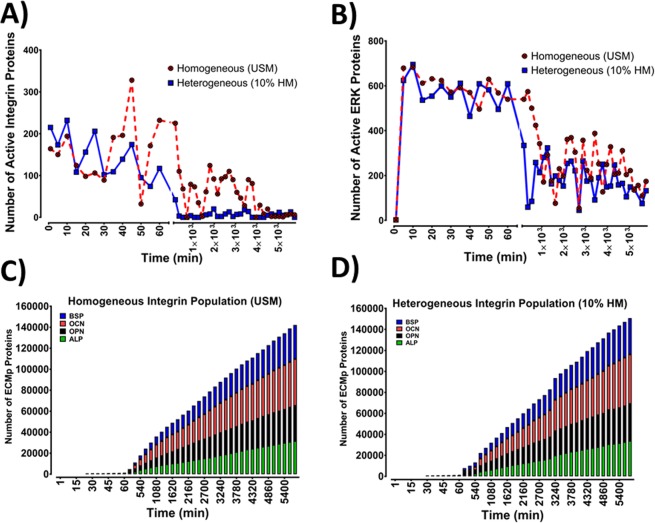Figure 4.
Comparisons between the ultrasensitive model (USM) and the heterogeneous model (10%-HM) of integrin mechanosensitivity, revealed that mechanotransduction maintenance depends on a fraction of total integrin population. (A) Illustration of the integrins activation behaviour of USM and 10%-HM within the initial 60 min and beyond 8 h of mechanical stimulation. At 0–60 min, the two models demonstrated similar activation behaviour and statistical analysis illustrated no significant difference between the two models. Response to mechanical stimulus and integrin activation was persistent past 4 days, nonetheless, the level of active integrins mediating mechanotransduction events were significantly lower in 10%-HM. (B) Mechanotransduction presented as pERK levels. At the initial phase (0–60 min), both models exhibited similar pERK activation dynamics where pERK maximal response was achieved during the first 7 ± 2 min after mechanical stimulation was applied, and pERK levels were sustained during the initial 60 min. Statistical analysis indicated no significant difference between the two models. After 16 hours, pERK levels were significantly reduced, yet mechanotransduction and pERK activation were maintained beyond 96 h (4 days). pERK levels were statistically lower in the 10%-HM in comparison to the homogeneous sensitive model. (C,D) Stacked bars illustrating the levels of accumulated ECMp overtime, it displays the four ECMps (OPN, OCN, ALP and BSP) at hourly intervals. There was no statistically significant difference between the two models for the four ECMps. Mechanical stimulation at the tissue level was a constant unidirectional shear stress. Data shown from one simulation (n = 1). Ultrasensitive model refers to Mech-ABM where integrin mechanosensitivity threshold was 1% of AFT, while the 10%-HM is a heterogenous model where the ratio between ultrasensitive and sensitive integrins was 1:10.

